North America Electric Vehicle Battery Manufacturing Equipment Market Size
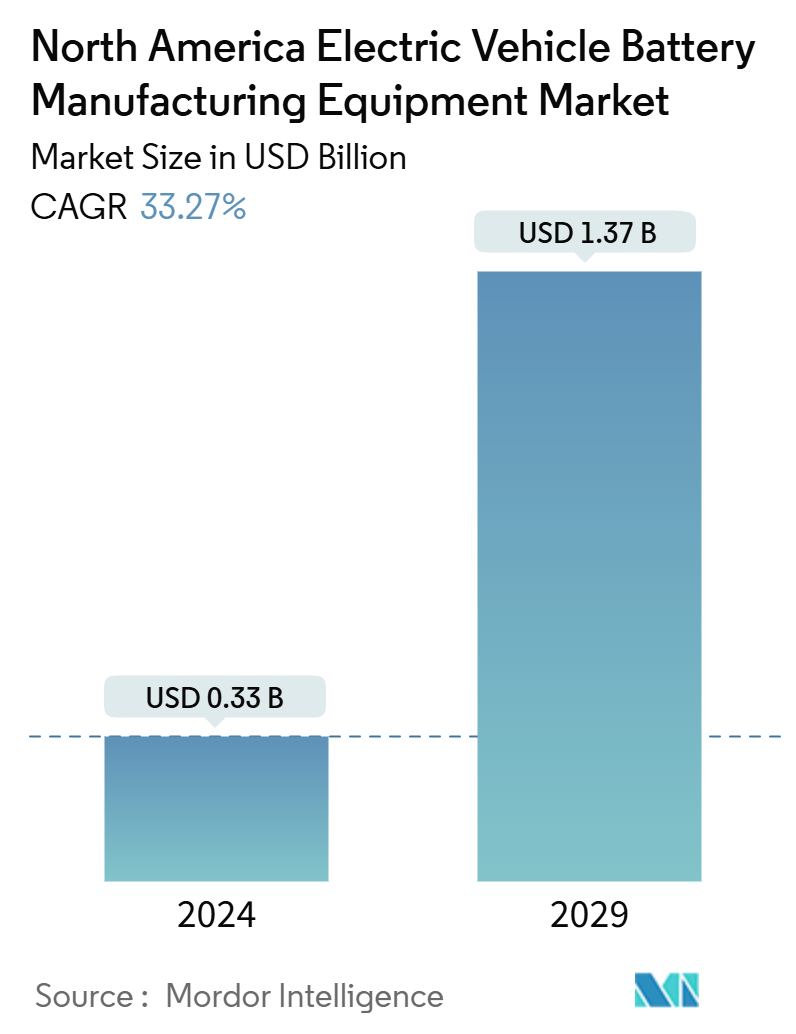
| Study Period | 2019 - 2029 |
| Base Year For Estimation | 2023 |
| Market Size (2024) | USD 0.33 Billion |
| Market Size (2029) | USD 1.37 Billion |
| CAGR (2024 - 2029) | 33.27 % |
| Market Concentration | Low |
Major Players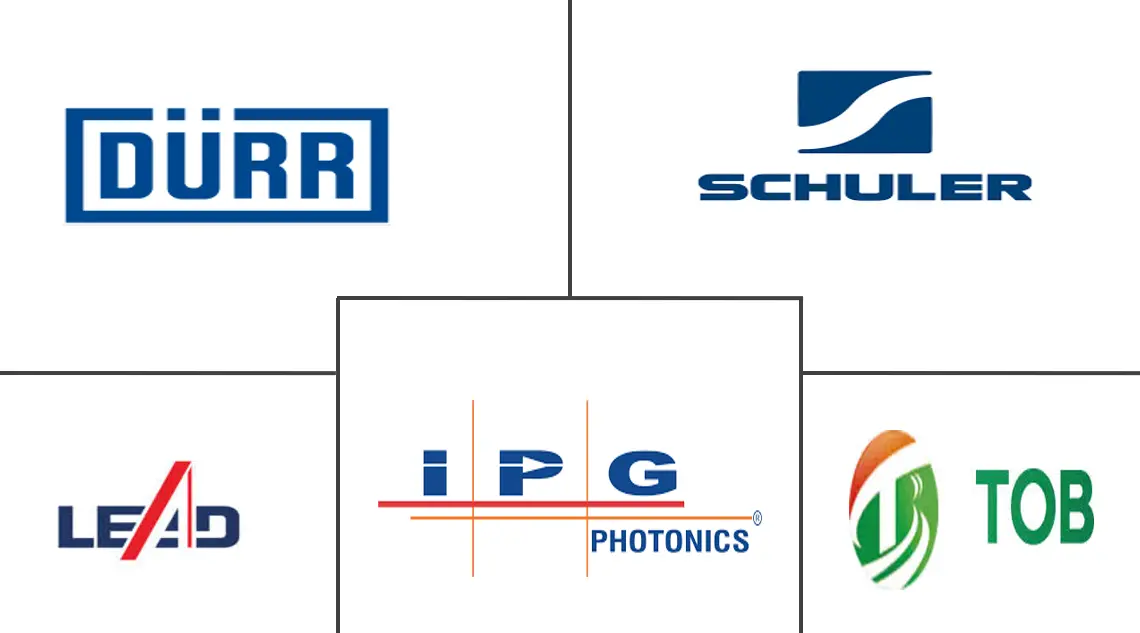
*Disclaimer: Major Players sorted in no particular order |
North America Electric Vehicle Battery Manufacturing Equipment Market Analysis
The North America Electric Vehicle Battery Manufacturing Equipment Market size is estimated at USD 0.33 billion in 2024, and is expected to reach USD 1.37 billion by 2029, at a CAGR of 33.27% during the forecast period (2024-2029).
- Over the medium term, factors such as the increasing adoption of electric vehicles in the region coupled with supportive government policies and regulations are expected to be among the most significant drivers for the North American Electric Vehicle Battery Manufacturing Equipment Market during the forecast period.
- On the other hand, established battery markets such as Asia Pacific are competing. This poses a threat to the North American Electric Vehicle Battery Manufacturing Equipment Market during the forecast period.
- Nevertheless, continued efforts to localize battery manufacturing supply chains in North American countries are expected to create several opportunities for the market in the future.
- United States is expected to dominate the market and will likely register the highest growth during the forecast period due to the government's rising efforts to establish battery manufacturing and the growing adoption of electric vehicles.
North America Electric Vehicle Battery Manufacturing Equipment Market Trends
Slitting and Electrode Making to Witness Significant Growth
- The slitting and electrode-making segment plays a pivotal role in North America's electric vehicle battery manufacturing equipment market. This segment underscores the importance of precision, efficiency, and adaptability, especially given the surging demand for electric vehicles. It involves a series of intricate processes that convert coated electrode materials into final structures, primed for assembly into battery cells. These cells are crucial for the performance and reliability of electric vehicle batteries.
- In North America, where the drive towards transport electrification is gaining momentum, the slitting process cuts large rolls of coated electrode material into narrower strips. These strips must meet precise specifications for various battery designs. Executing this process with high precision is paramount to avoid damaging delicate materials, including active lithium compounds and current collector foils, which are typically aluminum for cathodes and copper for anodes.
- As of January 2024, data from the National Renewable Energy Laboratory reveals a significant presence in North America's electrode and cell manufacturing landscape. The U.S. leads with 80 facilities and 66 companies, followed by Canada with 11 facilities and companies, and the rest of North America with four facilities and two companies.
- This underscores the vigorous growth of the electric vehicle (EV) battery manufacturing equipment market in North America. The multitude of facilities indicates a well-established infrastructure, crucial for meeting the rising demand for electric vehicles.
- After slitting, the electrode-making process commences. Here, individual strips are cut to precise dimensions and readied for assembly. This preparation may involve adding tabs and applying protective coatings or treatments to boost the electrode's performance and longevity.
- Furthermore, the North American market emphasizes innovation and sustainability, propelling advancements in slitting and electrode-making equipment. Manufacturers are actively seeking methods to minimize waste and bolster material recyclability. Innovations aim to enhance yield, reduce scrap, and implement systems for recovering and recycling excess materials or solvents from the electrode coating and preparation stages.
- For example, in September 2023, engineers at Oak Ridge National Laboratory introduced a groundbreaking dry battery manufacturing process. This innovation tackles the challenges of the traditional wet slurry method, which often depends on toxic solvents. Such reliance not only escalates manufacturing costs but also poses health and environmental risks. Oak Ridge's solvent-free process yields a battery that's lighter, more durable, and maintains a high energy storage capacity even after use.
- Given these advancements and the emphasis on precision, the slitting and electrode-making segment is poised for significant growth in the coming years.
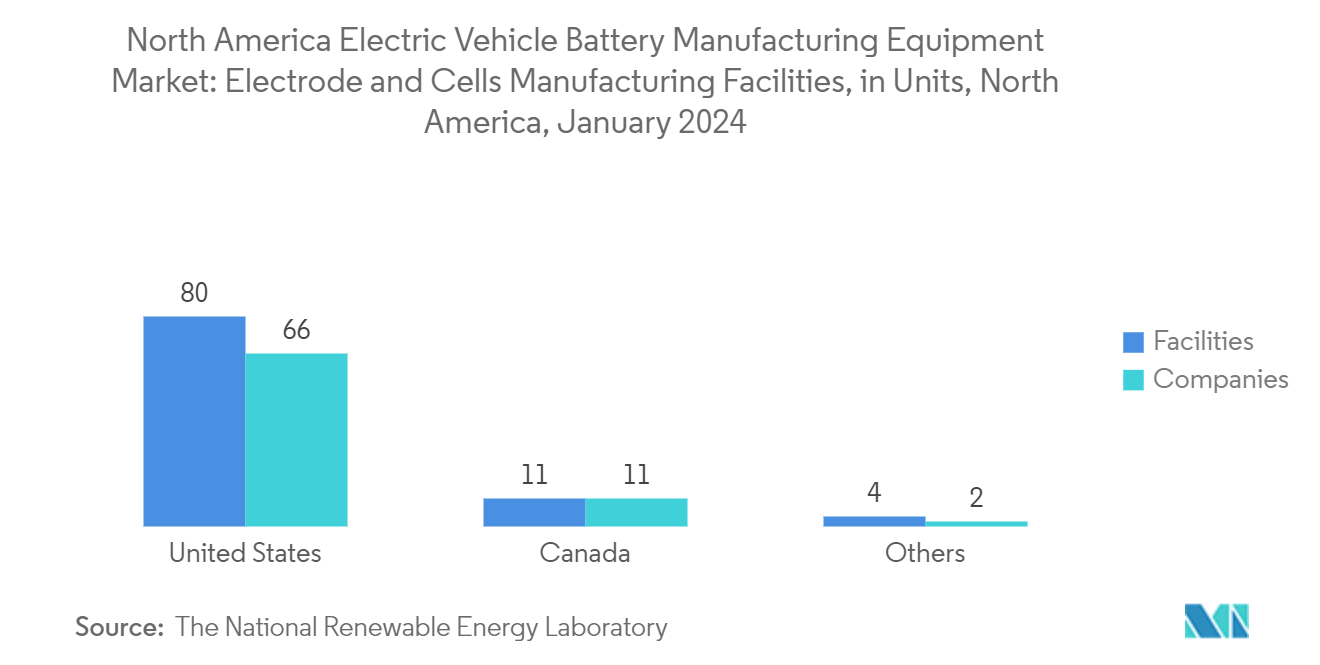
United States to Dominate the Market
- In the United States, the electric vehicle battery manufacturing equipment market is supported by a confluence of factors, including federal incentives, local government policies, and private investments that collectively enhance the industry's growth. For example, various tax credits and grants are available to companies that invest in battery manufacturing, which lowers the entry barrier for new players and supports the expansion of existing companies.
- For instance, starting in 2023, the United States government is offering Tax Credits via the Inflation Reduction Act, and Bipartisan Infrastructure Law laws have allocated a staggering USD 1 trillion in tax credits to facilitate the energy transition. Under the Inflation Reduction Act, battery producers benefit from manufacturing credits, receiving USD 35 per kilowatt-hour for battery cell production and USD 10 per kilowatt-hour for battery modules. Additionally, companies can claim a 10% reimbursement on costs for electrode-active materials. Notably, businesses have the flexibility to transfer or sell these tax credits to other taxpayers.
- Additionally, there is a strong push towards localizing the electric vehicle supply chain, which has led to increased investments in battery manufacturing facilities across the country. This trend is further bolstered by the United States government's stringent emissions regulations, which encourage automotive manufacturers to shift towards more sustainable, battery-powered vehicles.
- According to the National Renewable Energy Laboratory, as of January 2024, the United States boasted 64 companies operating in the battery manufacturing equipment sector, with 65 facilities spread across various regions. This robust infrastructure drives the growth of the Electric Vehicle Battery Manufacturing Equipment Market.
- Technological innovation is another cornerstone of the United States market, with numerous companies engaged in pioneering work to improve battery efficiency, reduce costs, and enhance the sustainability of battery production. The focus is not only on advancing lithium-ion technology but also on exploring alternative chemistries and solutions, such as solid-state batteries, which promise higher energy densities and improved safety profiles.
- Therefore, the United States is expected to witness significant growth during the forecast period, as mentioned above.
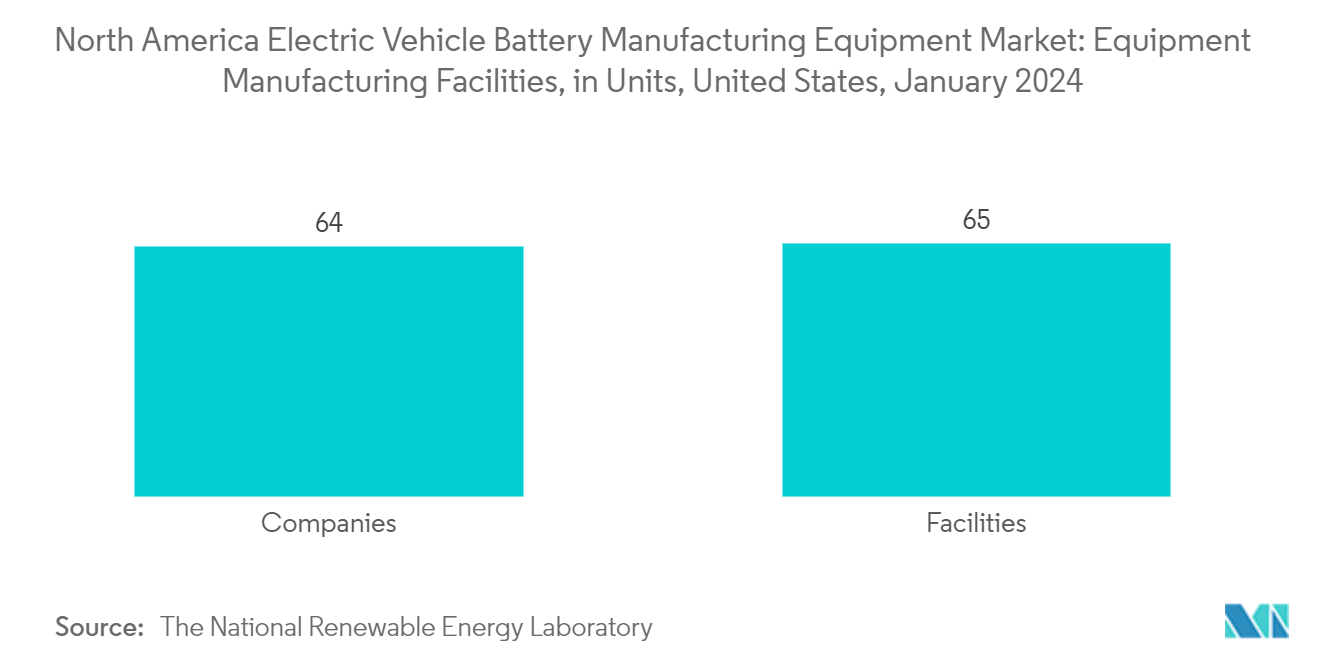
North America Electric Vehicle Battery Manufacturing Equipment Industry Overview
The North America Electric Vehicle Battery Manufacturing Equipment Market is semi-fragmented. Some of the key players in this market (in no particular order) are Duerr AG, Schuler AG, IPG Photonics Corporation, Wuxi Lead Intelligent Equipment Co. Ltd., and Xiamen TOB New Energy Technology Co., Ltd.
North America Electric Vehicle Battery Manufacturing Equipment Market Leaders
-
Duerr AG
-
Schuler AG
-
IPG Photonics Corporation
-
Wuxi Lead Intelligent Equipment Co Ltd
-
Xiamen TOB New Energy Technology Co., Ltd.
*Disclaimer: Major Players sorted in no particular order
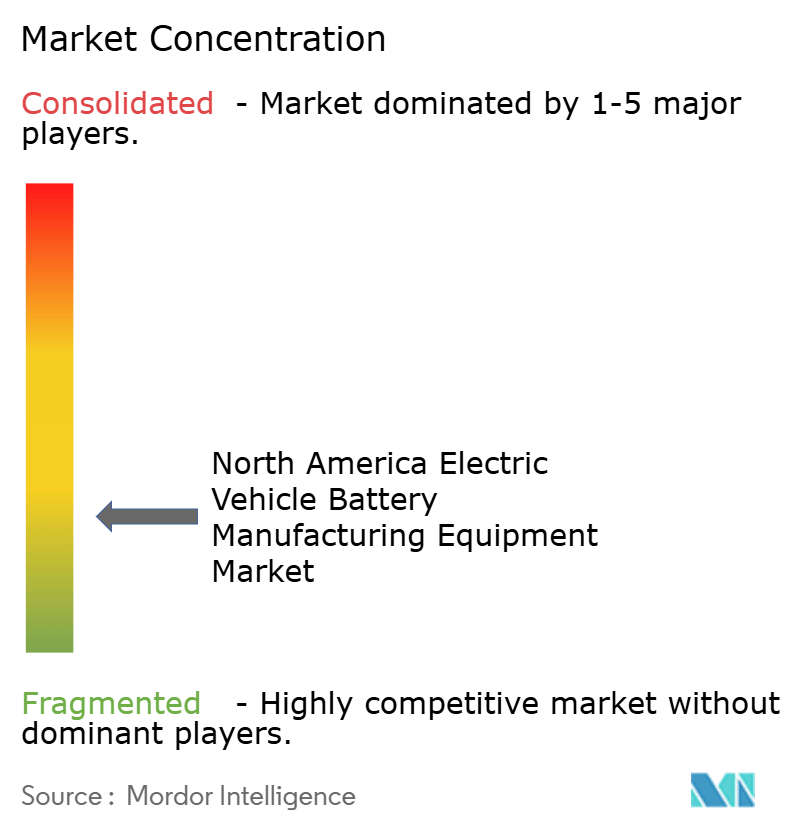
North America Electric Vehicle Battery Manufacturing Equipment Market News
- July 2024: The United States administration granted a conditional loan of USD 1.2 billion to Entek Lithium Separators, a branch of the Unitee States based battery equipment manufacturer, Entek. Entek, recognized for its pivotal role in battery equipment production, plans to channel the loan towards its USD 1.5 billion separator factory, currently being constructed in Terre Haute, Indiana.
- May 2024: Asahi Kasei has announced the establishment of its integrated lithium-ion battery (LIB) separator plant in Port Colborne, situated in Ontario's Niagara region, Canada. The facility, designated as Asahi Kasei Battery Separator Canada, is set to begin commercial production in 2027. It will manufacture Hipor wet-process separators, crucial and intricately designed components of lithium-ion batteries, primarily utilized in electric vehicles (EVs) and diverse energy storage applications.
North America Electric Vehicle Battery Manufacturing Equipment Market Report - Table of Contents
1. INTRODUCTION
1.1 Scope of the Study
1.2 Market Definition
1.3 Study Assumptions
2. EXECUTIVE SUMMARY
3. RESEARCH METHODOLOGY
4. MARKET OVERVIEW
4.1 Introduction
4.2 Market Size and Demand Forecast in USD, till 2029
4.3 Recent Trends and Developments
4.4 Government Policies and Regulations
4.5 Market Dynamics
4.5.1 Drivers
4.5.1.1 Increasing Adoption of Electric Vehicles
4.5.1.2 Supportive Government Regulations and Policies
4.5.2 Restraints
4.5.2.1 Competition From Established Markets
4.6 Supply Chain Analysis
4.7 Industry Attractiveness - Porter's Five Forces Analysis
4.7.1 Bargaining Power of Suppliers
4.7.2 Bargaining Power of Consumers
4.7.3 Threat of New Entrants
4.7.4 Threat of Substitutes Products and Services
4.7.5 Intensity of Competitive Rivalry
4.8 Investment Analysis
5. MARKET SEGMENTATION
5.1 Process
5.1.1 Mixing
5.1.2 Coating
5.1.3 Calendaring
5.1.4 Slitting and Electrode Making
5.1.5 Other Process
5.2 Battery
5.2.1 Lithium-ion
5.2.2 Lead-Acid
5.2.3 Nickel Metal Hydride Battery
5.2.4 Other Batteries
5.3 Geography
5.3.1 United States
5.3.2 Canada
5.3.3 Rest of North America
6. COMPETITIVE LANDSCAPE
6.1 Mergers and Acquisitions, Joint Ventures, Collaborations, and Agreements
6.2 Strategies Adopted by Leading Players
6.3 Company Profiles
6.3.1 Duerr AG
6.3.2 Schuler AG
6.3.3 Hitachi Ltd.
6.3.4 Xiamen Tmax Battery Equipments Limited
6.3.5 ACEY New Energy Technology
6.3.6 IPG Photonics Corporation
6.3.7 Wuxi Lead Intelligent Equipment Co Ltd
6.3.8 ACEY New Energy Technology
6.3.9 Xiamen Lith Machine Limited
6.3.10 Xiamen TOB New Energy Technology Co., Ltd.
- *List Not Exhaustive
6.4 List of Other Prominent Companies
6.5 Market Ranking/Share (%) Analysis
7. MARKET OPPORTUNITIES AND FUTURE TRENDS
7.1 Localization of Supply Chains
North America Electric Vehicle Battery Manufacturing Equipment Industry Segmentation
Electric vehicle (EV) battery equipment manufacturing refers to the production and assembly of the various components and machinery needed to create batteries for electric vehicles. This industry involves the development of specialized equipment used in the manufacturing process, such as mixing machines for electrode production, coating machines for applying active materials, and cell assembly machines for stacking and forming battery cells. The manufacturing process also includes the production of battery management systems, which ensure the efficient operation and safety of the battery packs.
The North America Electric Vehicle Battery Manufacturing Equipment Market is segmented by Process, Battery, and Geography (United States, Canada, and the Rest of North America). The process market is segmented by mixing, coating, calendaring, slitting, electrode making, and other processes. The battery market is segmented into lithium-ion, lead-acid, nickel metal hydride batteries, and others. The report also covers the size and forecasts for the Electric Vehicle Battery Manufacturing Equipment Market across major regions. The market sizing and forecasts have been done for each segment based on revenue (USD).
| Process | |
| Mixing | |
| Coating | |
| Calendaring | |
| Slitting and Electrode Making | |
| Other Process |
| Battery | |
| Lithium-ion | |
| Lead-Acid | |
| Nickel Metal Hydride Battery | |
| Other Batteries |
| Geography | |
| United States | |
| Canada | |
| Rest of North America |
North America Electric Vehicle Battery Manufacturing Equipment Market Research Faqs
How big is the North America Electric Vehicle Battery Manufacturing Equipment Market?
The North America Electric Vehicle Battery Manufacturing Equipment Market size is expected to reach USD 0.33 billion in 2024 and grow at a CAGR of 33.27% to reach USD 1.37 billion by 2029.
What is the current North America Electric Vehicle Battery Manufacturing Equipment Market size?
In 2024, the North America Electric Vehicle Battery Manufacturing Equipment Market size is expected to reach USD 0.33 billion.
Who are the key players in North America Electric Vehicle Battery Manufacturing Equipment Market?
Duerr AG, Schuler AG, IPG Photonics Corporation, Wuxi Lead Intelligent Equipment Co Ltd and Xiamen TOB New Energy Technology Co., Ltd. are the major companies operating in the North America Electric Vehicle Battery Manufacturing Equipment Market.
What years does this North America Electric Vehicle Battery Manufacturing Equipment Market cover, and what was the market size in 2023?
In 2023, the North America Electric Vehicle Battery Manufacturing Equipment Market size was estimated at USD 0.22 billion. The report covers the North America Electric Vehicle Battery Manufacturing Equipment Market historical market size for years: 2019, 2020, 2021, 2022 and 2023. The report also forecasts the North America Electric Vehicle Battery Manufacturing Equipment Market size for years: 2024, 2025, 2026, 2027, 2028 and 2029.
North America Electric Vehicle Battery Manufacturing Equipment Industry Report
Statistics for the 2024 North America Electric Vehicle Battery Manufacturing Equipment market share, size and revenue growth rate, created by Mordor Intelligence™ Industry Reports. North America Electric Vehicle Battery Manufacturing Equipment analysis includes a market forecast outlook for 2024 to 2029 and historical overview. Get a sample of this industry analysis as a free report PDF download.



